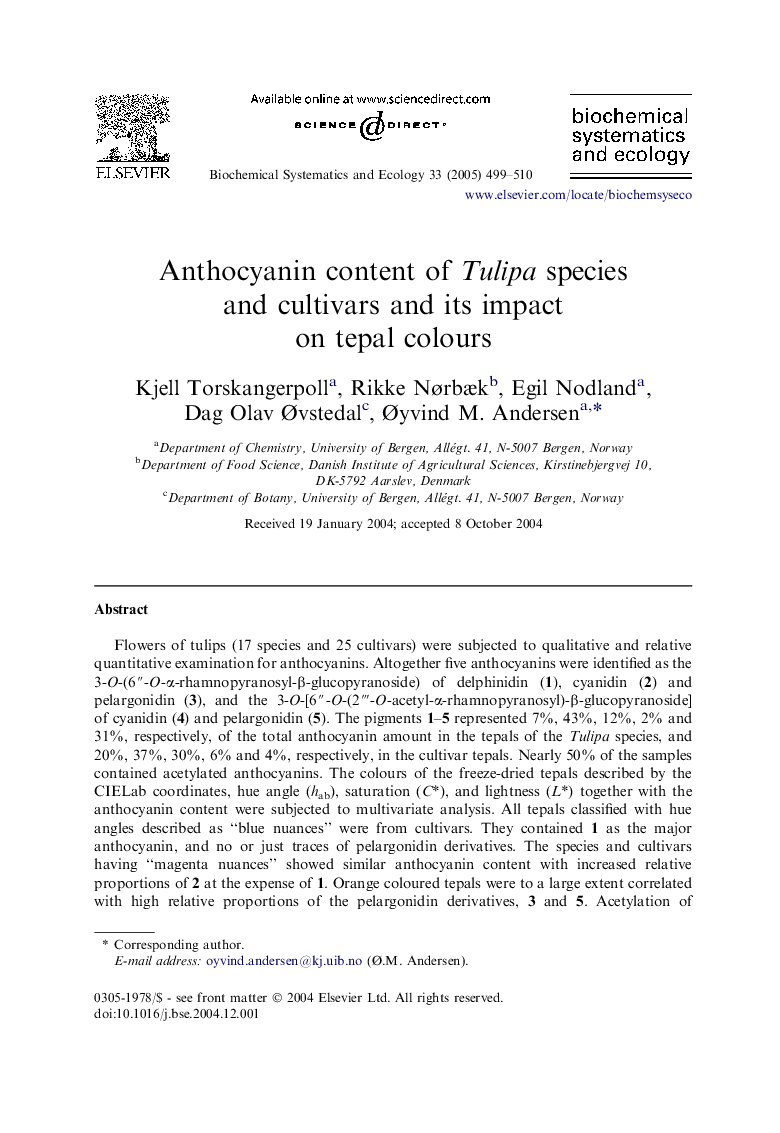| Article ID | Journal | Published Year | Pages | File Type |
|---|---|---|---|---|
| 10581742 | Biochemical Systematics and Ecology | 2005 | 12 Pages |
Abstract
Flowers of tulips (17 species and 25 cultivars) were subjected to qualitative and relative quantitative examination for anthocyanins. Altogether five anthocyanins were identified as the 3-O-(6â³-O-α-rhamnopyranosyl-β-glucopyranoside) of delphinidin (1), cyanidin (2) and pelargonidin (3), and the 3-O-[6â³-O-(2â´-O-acetyl-α-rhamnopyranosyl)-β-glucopyranoside] of cyanidin (4) and pelargonidin (5). The pigments 1-5 represented 7%, 43%, 12%, 2% and 31%, respectively, of the total anthocyanin amount in the tepals of the Tulipa species, and 20%, 37%, 30%, 6% and 4%, respectively, in the cultivar tepals. Nearly 50% of the samples contained acetylated anthocyanins. The colours of the freeze-dried tepals described by the CIELab coordinates, hue angle (hab), saturation (C*), and lightness (L*) together with the anthocyanin content were subjected to multivariate analysis. All tepals classified with hue angles described as “blue nuances” were from cultivars. They contained 1 as the major anthocyanin, and no or just traces of pelargonidin derivatives. The species and cultivars having “magenta nuances” showed similar anthocyanin content with increased relative proportions of 2 at the expense of 1. Orange coloured tepals were to a large extent correlated with high relative proportions of the pelargonidin derivatives, 3 and 5. Acetylation of anthocyanins furnished a weak colour effect opposite to the bluing effect previously reported for anthocyanins with aromatic acyl groups. All six species belonging to the section Eichleres (subgenus Tulipa) were after principal component analysis grouped closely together. They were characterized by high concentrations of the pelargonidin derivatives 3 and 5, and orange petal nuances. However, within section Tulipa (subgenus Tulipa), considerable anthocyanin variation was observed. Species in the subgenus Eriostemones were generally characterized by the two anthocyanins 1 and 2, and no pelargonidin derivatives.
Related Topics
Physical Sciences and Engineering
Chemistry
Organic Chemistry
Authors
Kjell Torskangerpoll, Rikke Nørbæk, Egil Nodland, Dag Olav Ãvstedal, Ãyvind M. Andersen,
